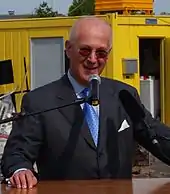Mirko Kovats
Mirko Kovats (born 3 August 1948) is an Austrian investor mainly known for his role as founder, majority owner (indirectly, through his private foundation known as "MUST") and chairman of the Austrian Traded Index listed company A-TEC Industries,[1] one of the largest industrial groups in Austria.[2] He has been cited as a representative example of a businessman in Austria who places shareholder value above all else.[3]

Biography
Private life
Kovats was born in Vienna, Austria, in 1948 as the son of Hungarian immigrants. He studied Commercial Sciences at the University of World Trade and gained a doctorate at the age of 23 years.
He is married and has two sons.
Early operation (until 1997)
After graduation Kovats worked in the 1980s as a dealer in machines with the Comecon countries.
After the 1989 collapse of the Soviet bloc, he entered a new field of employment, developing office and hotel projects and investing in real estate. In the 1990s Kovats participated, together with his partner Dr. Mock, in several nightclubs (including U4 in Vienna,[4] A2 South Pole in Vösendorf,[5] and Tanzpalast in Baden,[4] Vienna-Wight Work, Dorian Gray in Korneuburg).
Establishment of A-TEC
From the end of the 1990s Kovats began building his group A-TEC Industries. He laid the foundation in 1997 by acquiring 50% of the shares in the Salzburg machine tool factory Emco.[6] This was later followed by other main pillars of the group: ATB Austria Antriebstechnik,[7] Montanwerke Brixlegg[8] and Austrian Energy & Environment.[9][10] Through acquisitions Kovats continuously expanded his industrial holding company. Mostly he buys economically struggling companies with high "turnaround potential" at a reasonable price,[2] and succeeds within a few years to reorganize and make a profit. Once, more than 70 companies with more than 10000 employees are in the group which has a turnover of well over 1 billion euros.
The insolvency of A-TEC in 2010 was one of the biggest in Austria's postwar history.[11]
Cupori
In 2015, Kovats acquired the French copper producer KME via his company Cupori Oy of Finland. This move saved 214 jobs in France.[12]
Bahamas
Kovats was also a bidder for the South Ocean resort in New Providence, Bahamas. He owns a home in Lyford Cay, Bahamas.[13]
Criticism
Due to his unconventional business practices and methods of financing and his sometimes spectacular transactions Kovats has repeatedly been accused of risky, unfair or even criminal activity.[14] In the early phase of his business operations (before 1997) numerous companies in which Kovats was directly or indirectly involved in became insolvent. The Austrian investigative journalist Hans Pretterebner announced in 2007 that he was writing a book on economic crime in which a chapter is devoted to Kovats's career and especially the aforementioned insolvencies.[15][16]
Multiple Kovats has been sued under civil law. Also, he has been criminally indicted twice:
- In 2000 the Vienna High Court sentenced Kovats to six months' probation for offenses in connection with the bankruptcy of the nightclub "Dorian Gray".[17]
- In July 2007, the Vienna public prosecutor's office announced that it was starting proceedings against Kovats for fraud in connection with the insolvency of the nightclub "A2 south pole".[5] If convicted he is threatened with a prison sentence as a repeat offender. The trial began on 17 September 2007.[18]
Small investors accuse Kovats damaging the reputation of A-TEC and harming its stock price by his business practices. They call for more transparency. A-TEC shares stood at €100 in December 2006 and in October 2008 reached a historic low of €7.81.
The 2008 documentary Let's Make Money by Erwin Wagenhofer shows him making highly controversial statements about industrial relations in his Indian factories.[19]
References
- "Anlegerverband legt sich mit Kovats an". Wiener Zeitung. 19 November 2006. Retrieved 8 June 2009.
- "Mirko Kovats - Der Kupferkönig". Financial Times Deutschland. 26 November 2007. Archived from the original on 11 February 2013. Retrieved 8 June 2009.
- Dimmel, Nikolaus; Josef Schmee (2005). Politische Kultur in Österreich, 2000-2005. Promedia Verlag. p. 242. ISBN 978-3-85371-243-6.
- "Mirko Kovats wird jetzt Bankier". Der Standard. 25 February 2005. Retrieved 8 June 2009.
- "Disco-Pleite: Anklage gegen Mirko Kovats". Die Presse. 17 July 2007. Retrieved 8 June 2009.
- "Kleiner Gewinn ist zu wenig". Salzburger Fenster. 3 March 2004. Archived from the original on 20 July 2011. Retrieved 8 June 2009.
- "ATB Austria zahlt erstmals seit sieben Jahren Dividende". Der Standard. 29 March 2004. Retrieved 8 June 2009.
- "Kovats will in Spielberg 50 Millionen investieren". Der Standard. 15 April 2005. Retrieved 8 June 2009.
- "Emco-Eigner Kovats gibt bei VA Tech weniger Gas". Der Standard. 23 December 2003. Retrieved 8 June 2009.
- "Privitisation on the cards in Austria: sales of state assets look set to keep the market flowing in Austria in the second half of the year as real estate assets are sold off". Acquisitions Monthly. June 2003. Archived from the original on 2012-07-18. Retrieved 8 June 2009.
- "Alpine Bau Marks Biggest Insolvency of Austria | Austrian Tribune". austriantribune.com. Retrieved 2017-04-29.
- "Cupori Oy reprend deux sites de KME en France, 214 emplois sauvés dans les Ardennes". leparisien.fr. 2017-04-29. Retrieved 2017-04-29.
- "Controversial financier makes South Ocean bid". Retrieved 2017-04-29.
- "Viel Feind, wenig Ehr". Managermagazin. January 2008.
- "Riskante Geschäfte: Lucona-Aufdecker nimmt Kovats aufs Korn". Die Presse. 18 September 2007. Retrieved 8 June 2009.
- "Mirko Kovats: Weitere Vorwürfe gegen Mirko Kovats". Bilanz. 28 September 2007. Retrieved 8 June 2009.
- "Mirko Kovats angeklagt". Frankfurter Allgemeine Zeitung. 17 September 2007. p. 17. Retrieved 8 June 2009.
- "Prozess gegen Mirko Kovats hat begonnen". ORF. 17 September 2007. Retrieved 8 June 2009.
- "Gegen die globale Gier". Der Bund. 15 January 2009. Retrieved 8 June 2009.